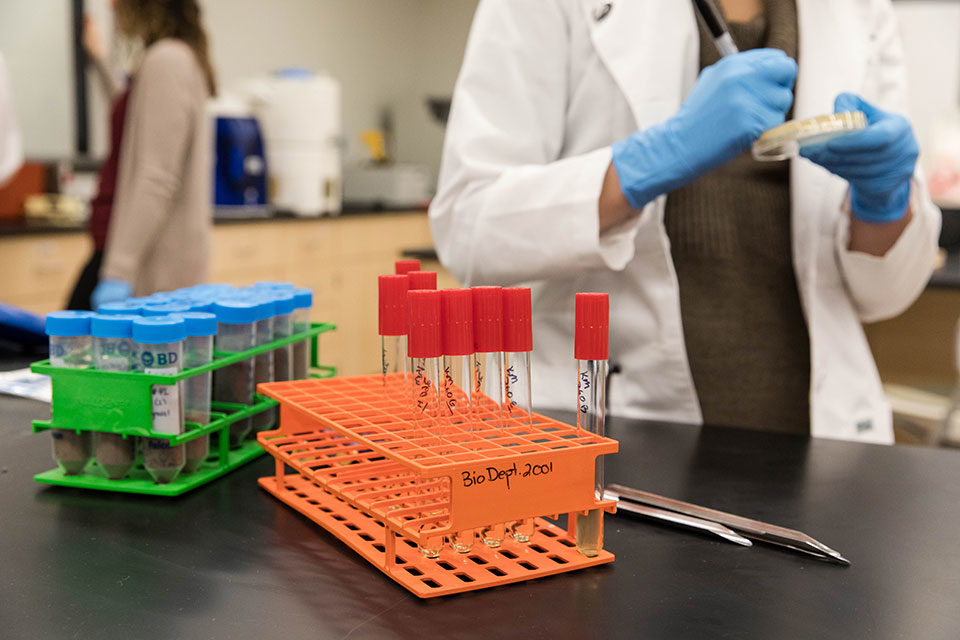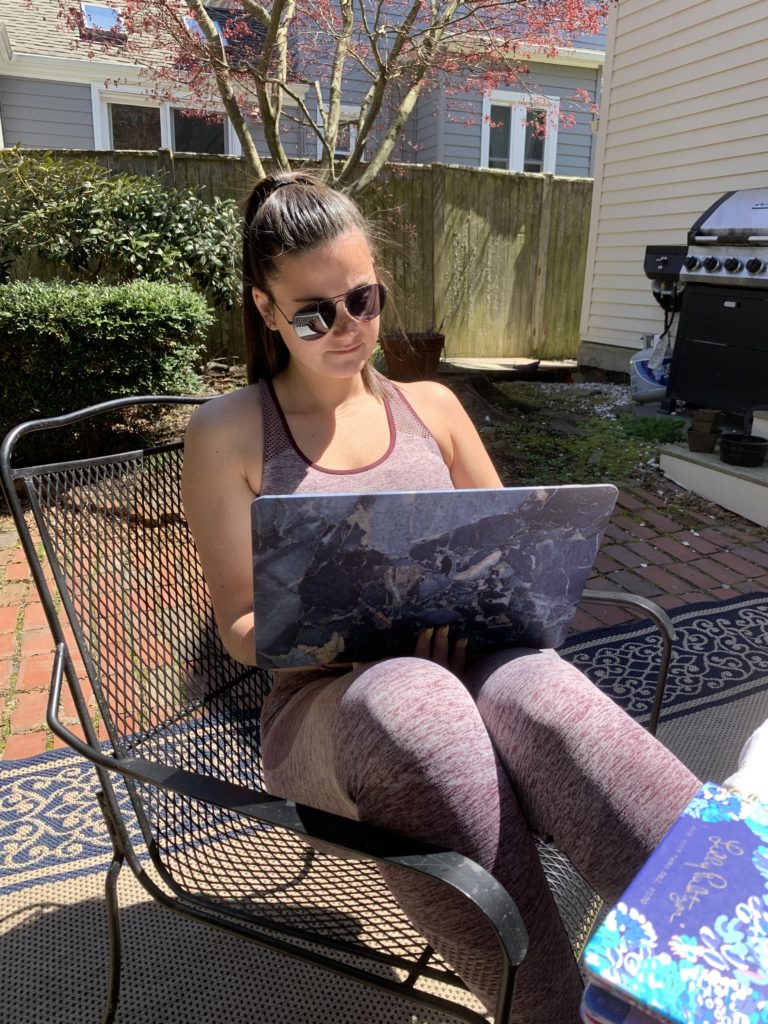Biology department tackles experiential learning, labs during remote learning

In any given year, the Department of Biology and Biomedical Sciences has between 150 to 200 undergraduate students majoring in different fields of study within biology. In addition to the quality academic classes that the department offers, one of the major things that distinguishes Salve Regina’s biology courses are the state-of-the-art lab equipment and research skills that students cultivate.
“It’s really hands-on learning,” described Dr. Steve Symington, associate professor and chairman of the biology department. “When our kids leave Salve, they have good technical skills. And typically, 85% of our kids participate in research experiences.”
But what does this look like when 200 or so students majoring in biology suddenly have to move home and complete remote learning for the rest of the semester? This was the challenge the professors within the biology department had to tackle as the world faced a pandemic.
Students finish CURE labs data analysis remotely
When it comes specifically to biology’s labs, the department hosts CURE labs—which stands for Course-Based Undergraduate Research Experiences. CURE labs are set up in a way where a student learns all the standard techniques that they would learn in a traditional lab, but they use these skills to answer novel research questions. This mirrors the real life scientific process, where things are much more exploratory and uncertain, better than traditional university labs when students often expect certain outcomes.
“In real science, you never know what the results are going to look like, and then part of the whole thing is learning how to interpret what you end up with and how to build on that knowledge to do other experiments,“ described Dr. Anne Reid, assistant professor of the biology department.
One of the courses that uses CURE labs is microbiology, which is taught by Reid. In this course, students get to learn about microbes in soil, and they come up with different hypotheses that they then test on a subset of the 1,200 trees that are part of the official Arboretum at Salve Regina.
“Students choose their own hypothesis, and students choose which trees they want to sample,” said Reid. “They do all the experimental design, the data collection, the data interpretation, the trouble shooting.”
Luckily, students had actually done most of their sample processing and data collection before they went remote. So the rest of the semester has been interpreting that data using bioinformatics. Using large online databases of genetic sequences, students have still been able to identify their bacterial samples and come to conclusions based around their hypotheses.
Christina Taft ’20, a biology major with chemistry and psychology minors, was part of a group of students who wanted to study the diversity of bacteria in blue spruce trees based on their proximity to the ocean. Their hypothesis was that if soil characteristics have an impact on the type of microbiome present within the soil, then there would be a difference in bacterial diversity between blue spruce trees close to and farther away from the ocean.
“We were able to go out to different locations in Newport where we could find these trees, and we took … samples,” Taft described. “[After remote learning began], Dr. Reid made it easy for us to complete the left-over tests and analyses by sending us our sequencing information and providing us with step-by-step worksheets. As someone who is already exposed to research, I enjoyed stepping out of my area of research and entering into a new area of biology.”
Using Labster for online lab simulations
The biology department already had a partnership with a technology tool call Labster, which is a software that creates online laboratory simulations, and they expanded this partnership after remote learning began. Labster creates virtual simulations of experiments where students can still enact out a lab even without having a lab setting or equipment in their homes.
“The simulations are powerful because if you actually make a mistake, something will happen – like you’ll blow up or there’ll be a fire,” Symington described. “So they’re made to be sort of real life where if you make a mistake, it shows the student they made a mistake.”
Dr. Kimberly Curesky, lecturer and health professions adviser for the biology department, has been using Labster in her courses during virtual learning, and she has found value in them even though being remote hasn’t been ideal for labs. As an example, Cureskly noted that she was able to use a Labster simulation comparing seals and humans and how more oxygen is stored in a seal’s blood than it is in a human’s, and it ran parallel to the cardiorespiratory sections that she was covering in her lecture.
“In that way, I found it to be helpful, possibly even more directly supplemental to the lecture material, because it allowed them to do things we wouldn’t be doing in a lab,” she said.
Samantha Bethoney ’23, has found value in the online labs. “I personally really enjoy completing the Labster [assignments],” she said. “They are interactive, interesting and are more of a parallel to real-life scientific work. The questions asked throughout guide you to ensure that you truly understand the information being taught to you, which I find valuable.”
Coronavirus ethical considerations in senior capstone course
In the senior capstone course for biology majors, the biology department always offers panel discussions on a variety of topics, including career preparation, becoming a global citizen and ethical considerations. Symington and Reid, who lead the capstone course, decided to pivot their discussions from usual ethical concerns to concerns around the coronavirus crisis since it is such a relevant topic for biology students.
In April, Curesky joined Dr. Peter Colosi, associate professor of philosophy, and Dr. Anthony LoPresti, associate professor of religious and theological studies, to discuss the ethics around coronavirus patients and choosing who should get a ventilator or not. The capstone course has also hosted a panel discussions on the government’s response to the pandemic and another with current alumni who are working across the country during this pandemic. The insights for students have been invaluable during such a volatile time.
Overall, while the semester took a surprising turn, it’s a time where everyone within biology has been given opportunities to grow, according to both Reid and Curesky.
“I actually really like that I’ve been forced to learn these things, because I think they are good tools to know moving forward,” said Curesky of being forced to use online tools. Reid expressed the same idea. “I will keep integrating elements of this into my live classes as I go on,” she said. “So there’s been a lot of cool things that have come from this that I think are useful and work really well as delivery methods for certain types of things.”
While nothing can replace the hands-on experiential learning so deeply a part of Salve Regina’s education, students are appreciative of the lengths that their professors and the biology department have gone to in order to ensure they continue to learn during this unprecedented time.
“Now more than ever, I am thankful that I go to a university with small classes where we were able to cultivate good relationships with the professors and our peers,” said Marina Clifford ’20, a biology major with a minor in chemistry. “Remote learning would become much more difficult if we had just been another face in a lecture hall.”
Check out stories every Tuesday that showcase the world of academics at Salve Regina and how faculty, programs and students are innovating with remote living and learning during Virtual Salve. #academictuesdays #salvesgotthis



